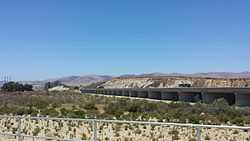Santa Maria River (California)
| Santa Maria River | |
| River | |
 Santa Maria River as seen from a bike trail on the Santa Barbara County side, with the 101 Freeway bridge visible | |
| Country | United States |
|---|---|
| State | California |
| Cities | Santa Maria, Guadalupe |
| Source | Confluence of Sisquoc River and Cuyama River |
| - location | South of Twitchell Reservoir |
| - elevation | 354 ft (108 m) |
| - coordinates | 34°54′11″N 120°18′45″W / 34.90306°N 120.31250°W |
| Mouth | Pacific Ocean |
| - location | Guadalupe Dunes County Park |
| - elevation | 0 ft (0 m) |
| - coordinates | 34°58′15″N 120°39′01″W / 34.97083°N 120.65028°WCoordinates: 34°58′15″N 120°39′01″W / 34.97083°N 120.65028°W |
| Length | 24.4 mi (39 km) |
| Basin | 1,760 sq mi (4,558 km2) |
| Discharge | for Guadalupe |
| - average | 30.2 cu ft/s (1 m3/s) |
| - max | 32,800 cu ft/s (929 m3/s) |
| - min | 0 cu ft/s (0 m3/s) |
Santa Maria River on the Central Coast of California, is formed at the confluence of the Sisquoc River and Cuyama River, just east of the city of Santa Maria, and flows 24.4 miles (39.3 km)[1] to its delta at the Pacific Ocean.
The entire river defines the border between northern Santa Barbara County and southern San Luis Obispo County, up to the Sisquoc River, with a major bridge on Highway 101 passing over it. The Santa Maria River Fault is a tectonic fault that roughly corresponds with the course of the river.
There are no dams or lakes on the Santa Maria River itself, although Twitchell Reservoir is formed by a dam on the tributary Cuyama River. Twitchell Dam was built by the United States Bureau of Reclamation and provides flood control and groundwater recharge of the aquifer. The Sisquoc River is also free-flowing, and a National Wild and Scenic Rivers System.
During much of the year, the Santa Maria River has very little water, but it can swell greatly during winter storms.
See also
References
- ↑ U.S. Geological Survey. National Hydrography Dataset high-resolution flowline data. The National Map, accessed March 15, 2011
Bibliography
- TPL (2007). "California Rivers Report: Central Coast Basin - Santa Maria River" (.PDF). The Trust for Public Land. Retrieved 2009-03-22.